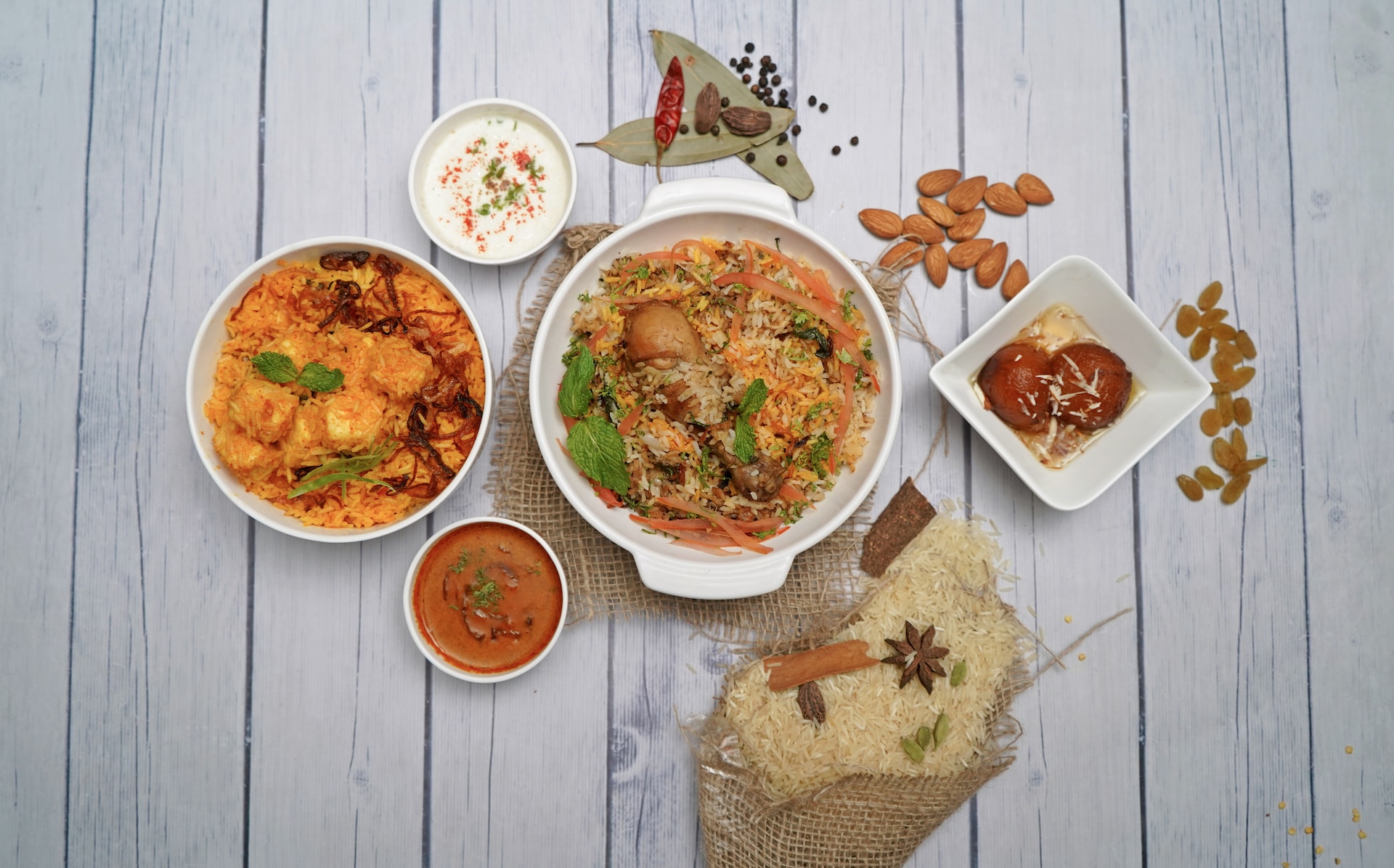Are there any spices that make food smell good? If you ever walked into a kitchen and instantly started salivating from the aroma of a tasty meal cooking. You might wonder, what spices are the secret ingredients that make food smell so amazing? Spices, my friend. Spices that make food smell good are like the cherry on top of a sundae. They can turn a plain dish into a flavor explosion. From cinnamon to turmeric to whole cumin seeds, the right spices can take your taste buds on a journey around the world. So let’s explore the delicious world of aromatic alchemy and uncover 10 spices that make food smell good.
Amazing Spices That Make Food Smell Good
I have tried many different spices over the years, but these are my all-time favorites. So without further ado, here are the common spices that make food smell good.
1: Ginger
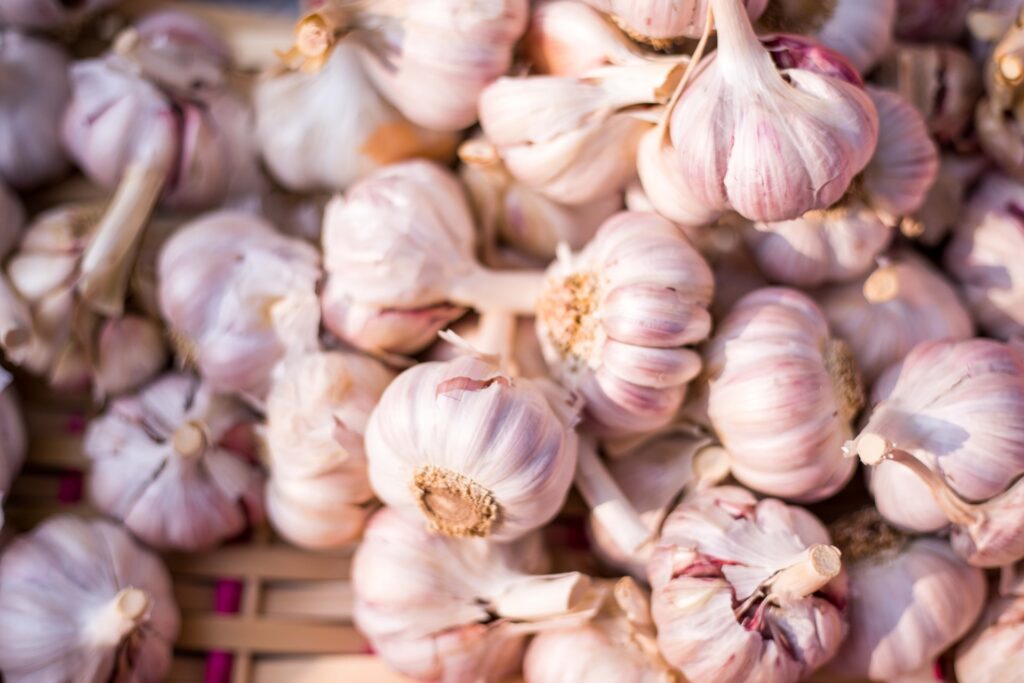
Ginger is a root spice commonly used in many Asian cuisines like Indian, Chinese, and Thai. It has a unique, pungent flavor and odor that adds an instant zing to any dish, making it all the more tasty. Just a small amount of ginger can transform bland dishes into mouth-watering delicacies. Whether raw or cooked, ginger releases a warm, fresh warming aroma that is hard to resist.
The distinct aroma of ginger is due to the presence of gingerols and shogaols, which are aromatic compounds present in the spice. These compounds are responsible for ginger’s spicy, peppery flavor and provide several health benefits. Gingerols and shogaols have anti-inflammatory, pain-relieving, and anti-nausea properties, making ginger an excellent addition to your diet.
Apart from being an excellent spice, ginger is popularly used to make tea and other drinks. Ginger tea is known for its soothing aroma and taste that can instantly lift your mood and energize you. When making ginger tea, you can slice fresh ginger and add it to boiling water, along with lemon and honey, to enhance its flavor. Ginger tea is perfect for cold winter days and can instantly relieve cough and sore throat.
2: Cardamom Pods
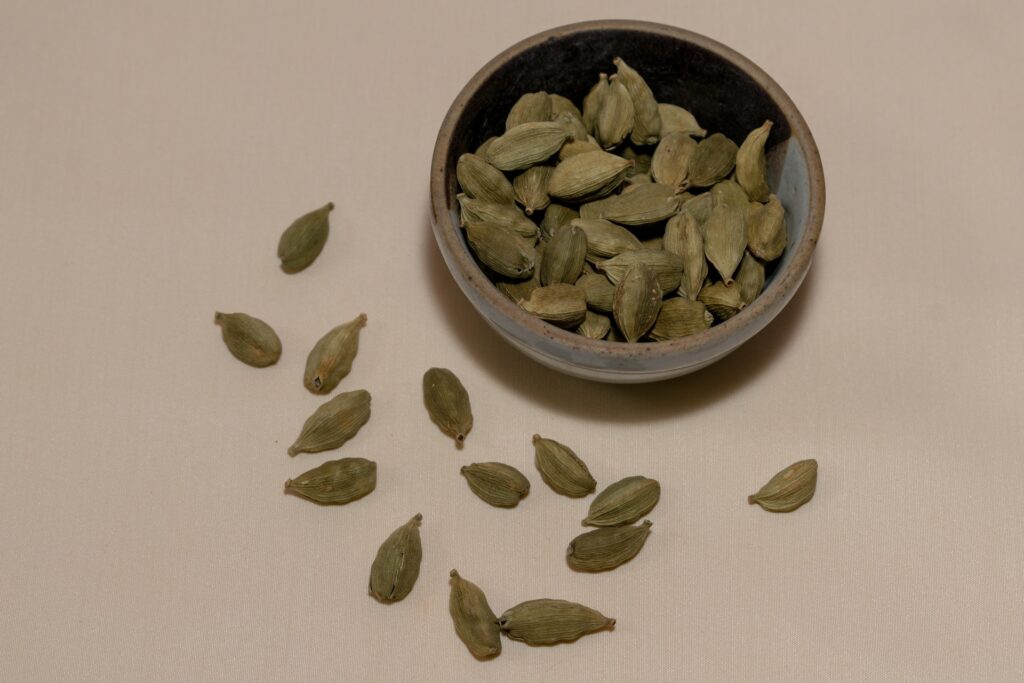
Cardamom Pods are small green pods often used in desserts, pastries, teas, and curries. The spice is indigenous to India and grown in other tropical countries like Guatemala and Sri Lanka. The two types of Cardamom Pods are Green Cardamom Pods and Black Cardamom Pods. Green Cardamom Pods are more popular and widely used than Black Cardamom Pods. The green pods have a sweet and floral taste, whereas the black ones have a smoky and earthy flavor
One of the primary reasons Cardamom Pods make food smell good is the presence of essential oils in the pod. These oils carry the spice’s flavor and aroma, which penetrates the food. Cardamom Pods also contain cineole, a natural antiseptic that helps freshen the breath. Hence Cardamom Pods are also used in oral hygiene products like chewing gums and mints.
Cardamom Pods have several health benefits besides adding flavor and aroma to your food. It is a natural remedy for digestive problems like bloating, indigestion, and nausea. It also has anti-inflammatory properties, which help in reducing inflammation in the body. Cardamom Pods also regulate blood sugar levels, which benefits those with type 2 diabetes. The spice is also known to have a calming effect on the body, which aids in reducing stress and anxiety.
3: Cumin
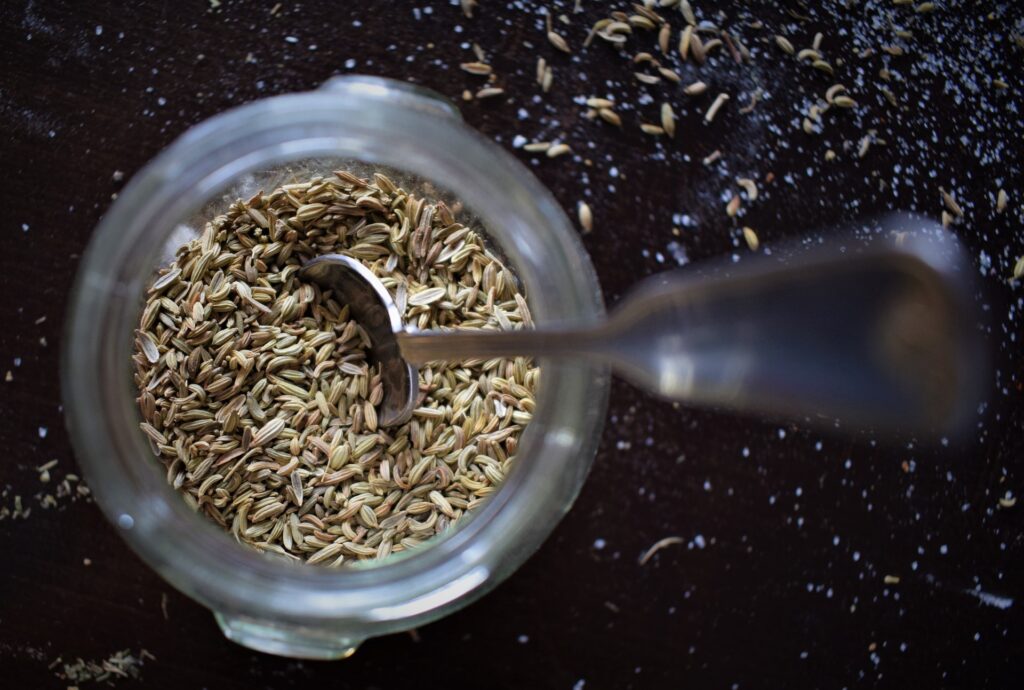
Cumin is an annual herb widely used in cuisines worldwide, particularly in Mexican, Indian, and Middle Eastern cuisine. When used in moderation, cumin provides a rich flavor to dishes. However, while cooking with cumin, I love the smell it brings into my kitchen. Cumin releases a warm, nutty, and slightly sweet aroma that fills the air and stimulates my senses when added to a dish. The smell of cumin alone makes my mouth water and excites me about the cooking meal.
Cumin is widely used in spice blends such as garam masala, taco seasoning, and chili powder. And the smell of these spice blends alone makes me want to savor the dish before it’s even ready. When using these spice blends, cumin is often paired with other spices, such as coriander, chili powder, and paprika, which makes the aroma more complex and tantalizing. The combination of these spices elevates the dish’s aroma and creates a mouthwatering smell that entices your senses.
Another reason why I love cumin is because of how versatile it is. Not only can it be used in savory dishes such as stews, soups, and curries, but it is also a great addition to baked goods such as bread, pastries and savory snacks like spiced nuts. The smell of cumin in baked goods adds a warm and comforting aroma that lingers in your kitchen and throughout your home. Whether making a sweet and savoury dishes, cumin is a spice that will always make your food smell good.
4: Cloves
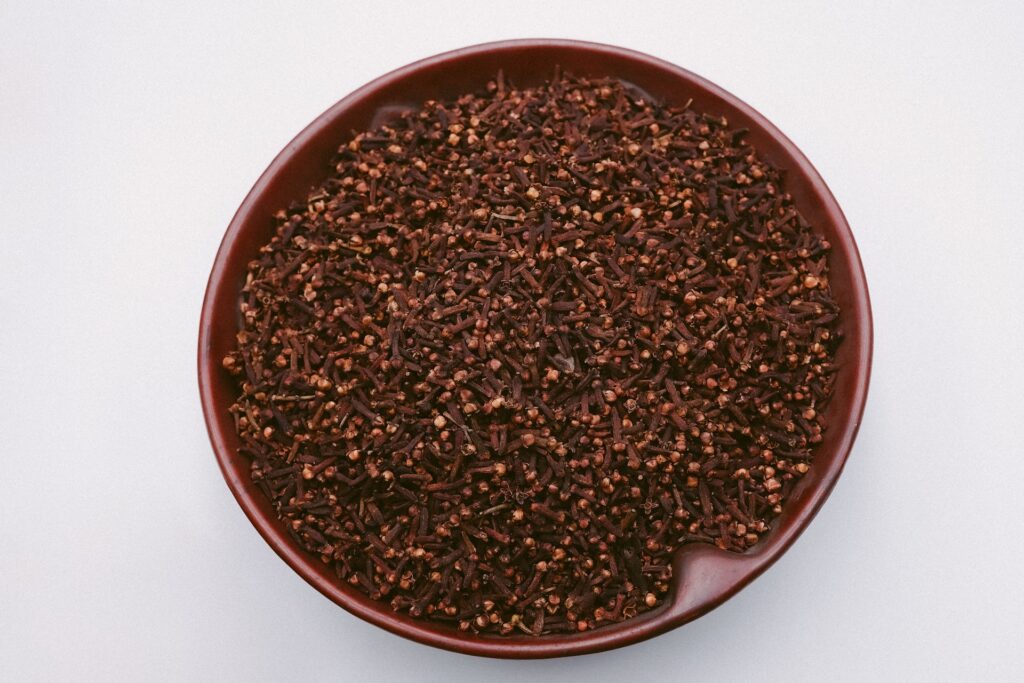
Cloves (Syzygium aromaticum) are the dried flower buds of an evergreen tree native to Indonesia. They’re slightly curved and have a hard, woody texture with a warm brown color. When you crush or grind them, they release a potent aroma and a distinctive flavor that’s both sweet and savory at the same time. Cloves have a rich history – they were used in ancient Chinese medicine to help treat everything from nausea to hernias, and in Europe, they were considered a luxury spice that was only available to the wealthy.
In cooking, cloves are incredibly versatile and can be used in both sweet and savory dishes. They pair particularly well with warm spices like cinnamon and nutmeg, which makes them a staple in many holiday recipes, such as pumpkin pie, spiced cider, and gingerbread cookies. Cloves are also an essential ingredient in many Indian curries and biryanis, where their warm, earthy flavor helps balance the chilies’ heat.
But it’s not just about the taste of cloves – they’re also incredibly aromatic and can add an irresistible scent to your food. I love using them to infuse syrups and marinades for meat dishes, like honey and clove glazed ham or a slow-cooked beef stew. The smell of the cloves wafting through the kitchen is enough to make your mouth water.
5: Bay Leaf
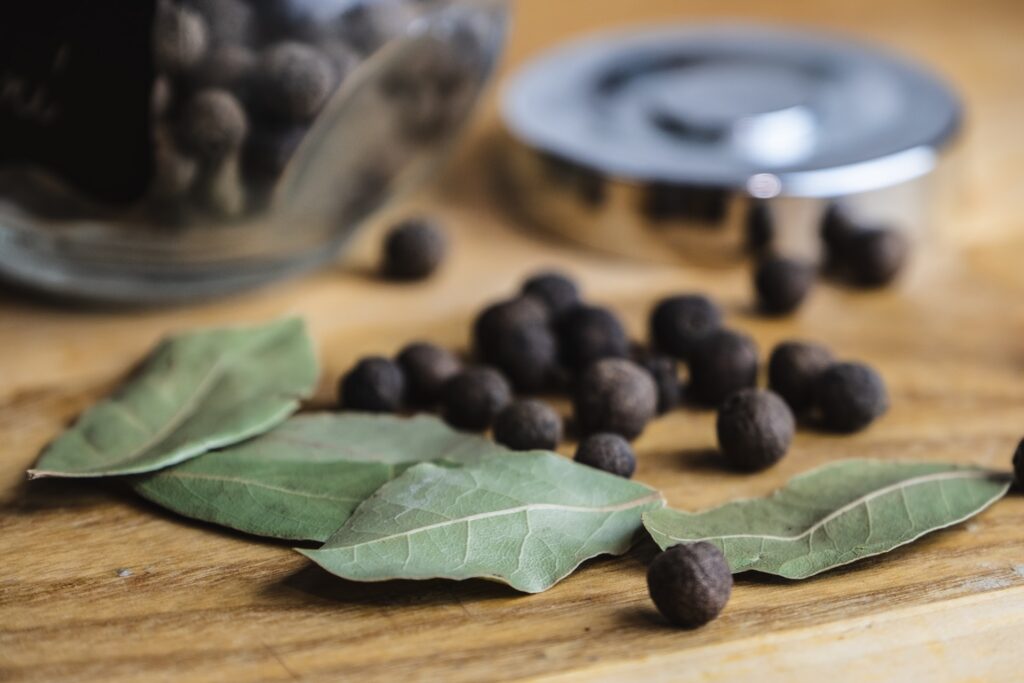
Bay leaves have been in use for centuries, dating back to the ancient Greeks and Romans, who believed that the leaves from the Bay Laurel tree had symbolic and medicinal properties. These fragrant oval-shaped leaves are used in various cuisines worldwide, such as Mediterranean, Indian, and Caribbean cooking. Bay leaf is a potent spice with a strong and sharp aroma that complements meat, poultry, seafood dishes, soups, stews, and sauces. It has a slightly bitter taste that adds complexity and depth to any recipe, making it a staple in every pantry.
One of the unique properties of Bay leaf is the essential oil it contains, which is responsible for its distinct aroma. When the leaves are dried, they slowly release the oil, providing a slow-burning fragrance that infuses the food during cooking. Therefore, removing the leaves before serving is advisable since no one wants to bite into a leaf. I always feel satisfied when I see the aroma wafting through my kitchen when I add the bay leaves to my dishes.
Bay leaf also has numerous health benefits. It contains compounds such as eucalyptol, cineol, and pinene, which are excellent for respiratory and digestive health. Apart from its health benefits, Bay leaf is also an economic spice. It is relatively inexpensive and readily available at most grocery stores. No wonder it’s used in many recipes. Its versatility is another advantage, as it pairs well with various spices such as cumin, thyme, rosemary, and fresh oregano. From my experience, using bay leaf helps reduce salt usage in most dishes, infusing your meal with concentrated flavor.
6: Basil
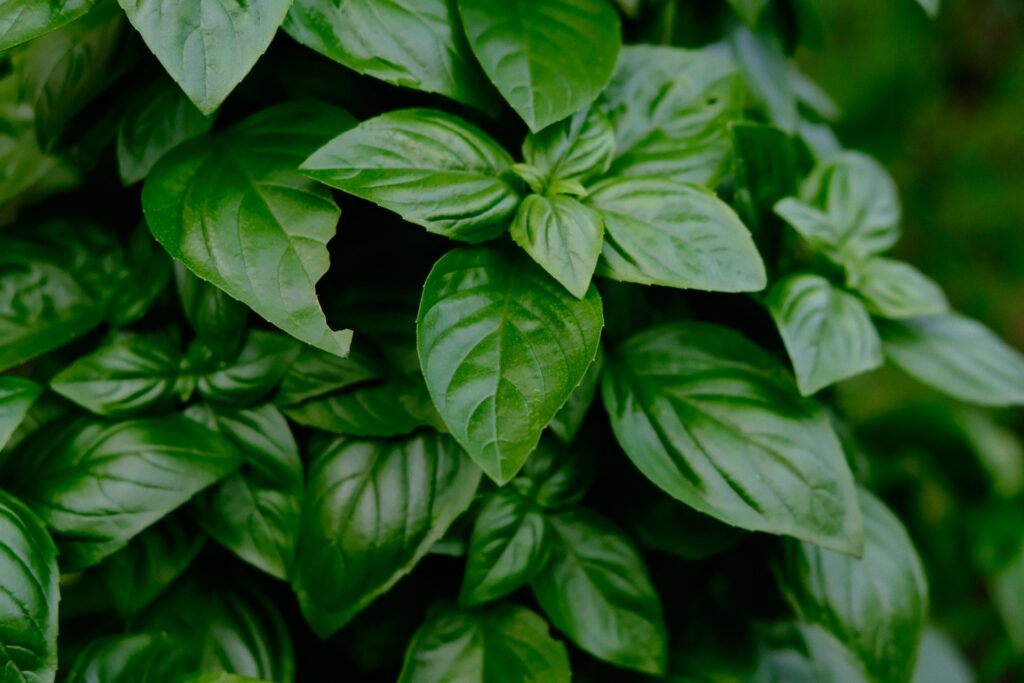
Basil has been widely used in Mediterranean and Italian cuisine for centuries, but it has now become a staple in kitchens all over the world. Its unique flavor profile comes from its essential oils, concentrated in the leaves. You can describe the scent as warm and earthy with a slightly sweet and spicy aroma. This combination of flavors makes basil an incredibly versatile herb that can be used in savory and sweet recipes alike.
The rich and aromatic scent of basil is often associated with summer gardens and freshness. It brings a sense of warmth and comfort to any dish, even on a cold winter day. Whether you’re making a classic tomato and basil pasta sauce or sprinkling fresh basil leaves on a Caprese salad, the smell of this herb is irresistible. You can also use it in soups, stews, and marinades to add a layer of flavor that will take your dish to the next level.
Another reason why basil is one of the spices that make food smell good is because it’s packed with essential nutrients and antioxidants. Basil is an excellent source of vitamin K, vitamin C, manganese, and copper. These nutrients help to protect your body against cellular damage and promote healthy digestion. By incorporating basil into your meals, you not only add amazing flavor but also boost your health.
7: Mace
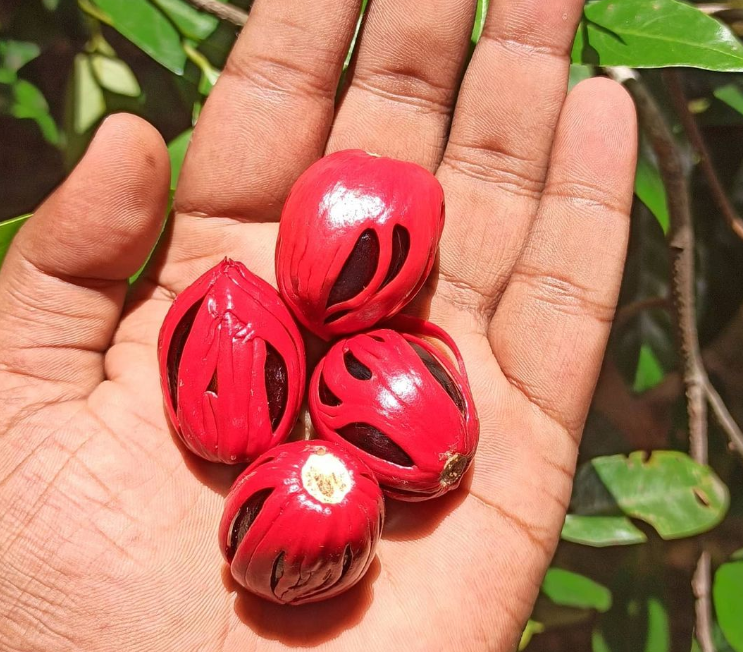
Mace is an often overlooked spice, yet it is an essential ingredient that can do wonders for your dishes. So what exactly is mace? It is a spice derived from the dried outer coating of nutmeg seeds. It has a distinct earthy aroma, a cross between cinnamon and black pepper, with hints of cloves and nutmeg. The fragrance is sweet, and warm making it an excellent addition to sweet and savory dishes.
When used in cooking, mace adds depth and complexity to the flavors of your dishes. In savory dishes like stews, soups, and curries, mace enhances and deepens the spices’ flavors, adding a mild sweetness and floral undertones. It also pairs beautifully with meats like lamb, beef, and chicken, adding a unique flavor to these proteins. In sweet dishes, mace is often used in baking, adding warmth and depth to desserts like cakes, pies, and custards.
One of my favorite dishes that incorporate mace is the classic béchamel sauce. Adding mace elevates the sauce’s flavors, adding a subtle sweetness and floral notes to it. I also love using it in my roasted sweet vegetables, like sweet potatoes and carrots, as they add a warm and nutty flavor. Another great way to use mace is to sprinkle it on top of a hot cocoa mug for a cozy and comforting winter treat.
8: Star Anise
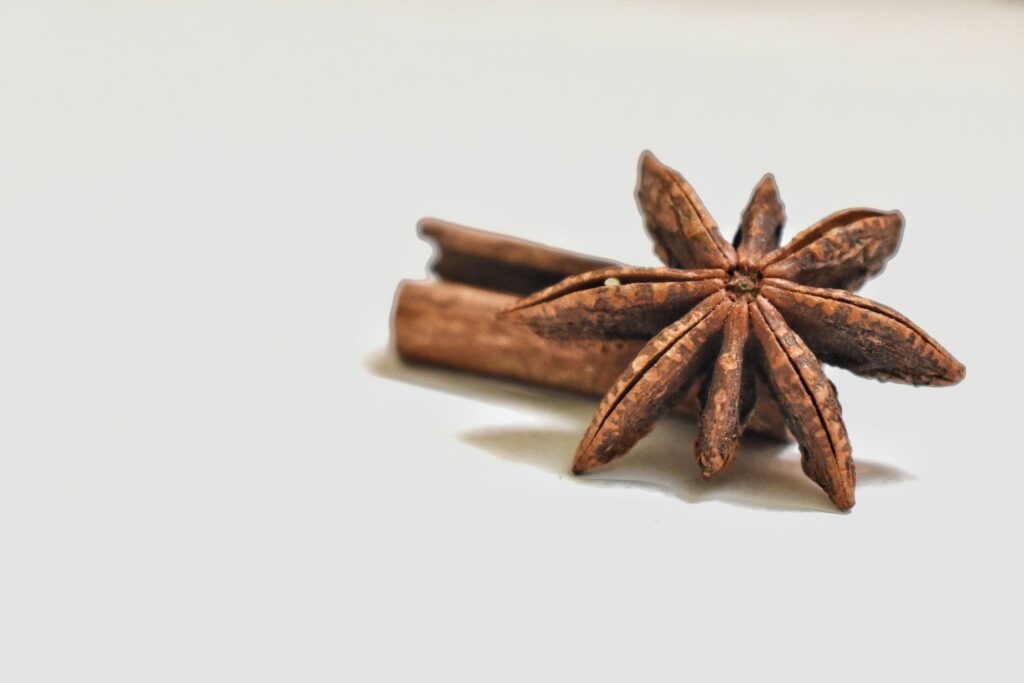
It is a star-shaped fruit from the evergreen tree Illicium verum, native to Southeast Asia. It has a sweet and aromatic flavor with hints of licorice, making it a popular spice ingredient for Middle Eastern, Chinese, and Indian cuisine. What I found interesting about star anise is that it is not only used for its flavor but for its aroma as well. It is often added whole or ground to add fragrance to baked goods, teas, and potpourri. Whenever I use star anise in my cooking, I feel like I am adding an exotic touch to my dish.
One of the most prevalent uses of star anise is in Chinese five-spice powder. The spice mix consists of five spices: star anise, cinnamon rolls, cloves, fennel seeds, and Szechuan pepper. It is famously used in Chinese braised dishes and marinades. Whenever I make Chinese-style pork or chicken, I use this spice blend, and the aromas fill my kitchen, making me feel like I am in a Chinese restaurant.
Apart from its culinary uses, star anise has several health benefits too. It contains antioxidants, antibacterial and anti-inflammatory properties. Star anise tea alleviates digestion, cough, and cold symptoms. The essential oil derived from star anise is used in medicinal products such as cough syrups, toothpaste, and mouthwash. So using star anise in your cooking not only adds flavor but helps improve your health too.
9: Turmeric
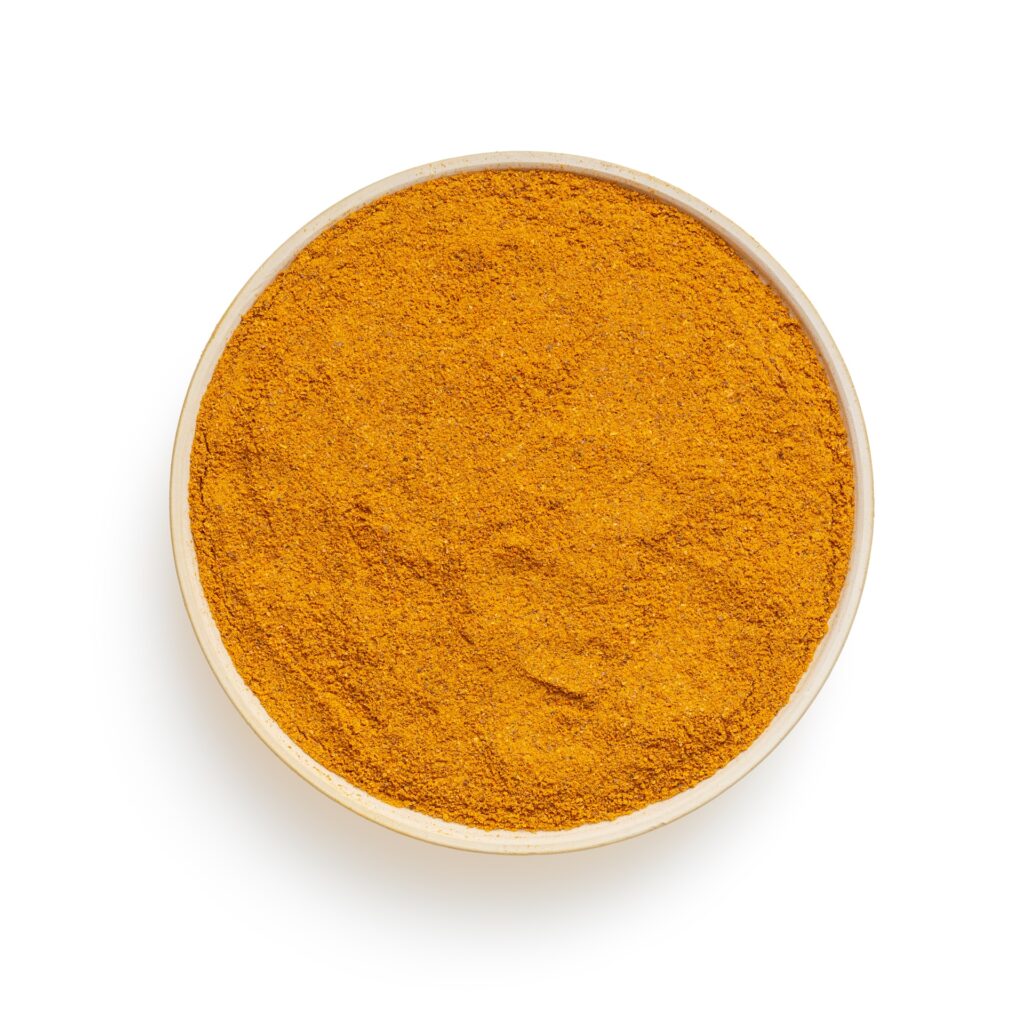
Turmeric, or “Indian saffron” as it’s sometimes called, is a root that belongs to the ginger family. It is commonly used in Indian and Southeast Asian cooking and has been renowned for its medicinal and culinary benefits. One of the most alluring aspects of turmeric is its unique, earthy aroma. It has a slightly sweet and tangy scent that can enhance the flavors of any dish. I love using turmeric to cook chicken or potatoes as it gives off an irresistible fragrance filling my entire kitchen.
Another unique quality of turmeric is its vibrant yellow color. It has been used for centuries as a natural dye for clothing and carpets. When added to food, it can turn it a beautiful golden color pleasing to the eye. I especially love adding turmeric to my rice dishes like pilaf or biryani to give them that extra pop of color.
In addition to its signature aroma and color, turmeric is also known for its health benefits. It contains a compound called curcumin which has been shown to have anti-inflammatory properties and may even help reduce the risk of cancer. Incorporating turmeric into your diet can be an excellent way to gain these health benefits and add more flavor to your dishes.
10: Saffron
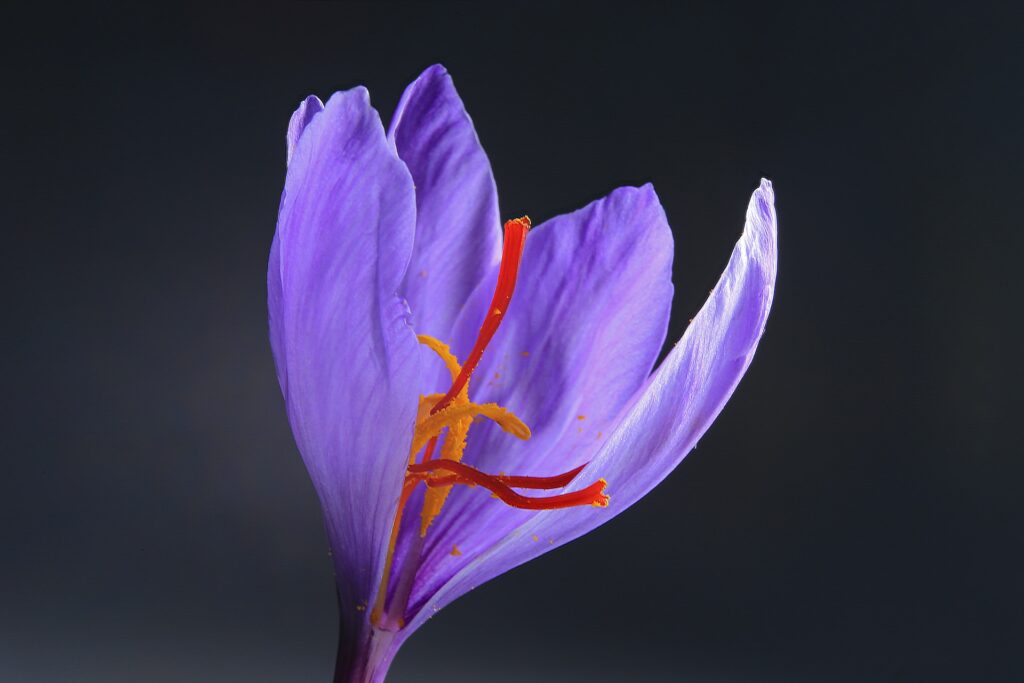
Saffron is derived from a flower called Crocus sativus, which grows in eastern Mediterranean countries and parts of southwestern Asia. The spice is the flower’s stigma, which is dried and used as a seasoning. Like the flower, saffron’s fragrance is potent, with a floral and slightly sweet smell. This scent adds an extra dimension to any dish and takes it from good to great.
One of the reasons why saffron is considered an essential spice is its versatility. It works well in sweet and savory dishes and pairs well with other spices such as cinnamon, nutmeg, and cardamom. What’s more, saffron is used in different cuisines worldwide, from the paella of Spain to the biryani of India and the Middle East. Its ability to blend well with a range of flavors and cuisines is one of the reasons why it’s hailed as one of the spices that make food smell good.
Aside from being a delicious spice, saffron has several health benefits. It’s rich in antioxidants that help fight inflammation in the body and improve heart health. Studies have shown that saffron may also positively impact mood and mental health. Aromatherapists also use the scent of saffron for relaxation and stress relief. The spice’s sweet aroma has been known to provide a calming effect that clears the mind and elevates one’s mood.
These are just some spices that can add flavor and fragrance to your cooking. Experimenting with different spices is a great way to explore new flavors and create unique dishes.
Frequently Asked Questions
Can spices help mask unpleasant odors in certain foods?
Yes, spices can help mask unpleasant odors in food. Some spices have strong and distinctive scents that can overpower unpleasant smells in certain foods. For instance, adding cinnamon or vanilla to your oatmeal can mask the smell of boiled oats. Similarly, adding curry powder, ginger, and garlic powder to strong-smelling meats like mutton or goat can help reduce the stinky odor. It’s essential to note that you should not use spices to conceal spoiled or rotten food odors.
How can I use spices to create a signature scent in my cooking?
Creating a signature scent in your cooking involves using a unique combination of spices that complements your preferred taste profile. For instance, if you like spicy foods, you can blend chili, cumin, and coriander to create a spicy aroma. Alternatively, you can use clove, cardamom, cinnamon, and nutmeg to create a warm and sweet scent. The key is to experiment and find what works for your palette.
Do different cuisines utilize specific spices to achieve distinct aromas?
Yes, different cuisines use specific spices to achieve distinct aromas and flavors. For example, Indian cuisine uses a blend of spices like cumin, turmeric, coriander, and cardamom to create a unique flavor profile. Similarly, African cuisine uses spices like berbere, cumin, fenugreek, and harissa to add heat and richness to their dishes. Mexican cuisine uses chili, cumin, and oregano to add flavor to their sauces and dishes.
Can the aroma of spices affect our appetite and enjoyment of food?
Yes, the aroma of spices can affect our appetite and enjoyment of food. Our sense of smell plays a significant role in our sense of taste. When we smell delicious aromas from spices, our brain releases endorphins that produce feelings of pleasure and happiness. Additionally, spices can stimulate our digestive system and improve blood flow to the stomach, enhancing our appetite and digestion.
Can spices be combined to create unique and enticing scent profiles in dishes?
Yes, spices can be combined to create unique and enticing scent profiles in dishes. For instance, combining cinnamon, ginger, and nutmeg can create a warm and spicy aroma in baked goods. Likewise, combining cumin, coriander, and garam masala can create an exotic and fragrant aroma in Indian dishes. The key is to experiment and find what works for your cooking dish.
Final Words
After researching the spices that make food smell good, I am blown by the immense variety out there! From the refreshing scent of ginger to the warm aroma of cinnamon, many spices can take a dish to the next level. It’s incredible how just a pinch of a certain spice can make all the difference in the world. I can’t wait to experiment in the kitchen and test these fragrant spices in my next meal. Who knows, maybe I’ll even invent my own signature spice blend!

